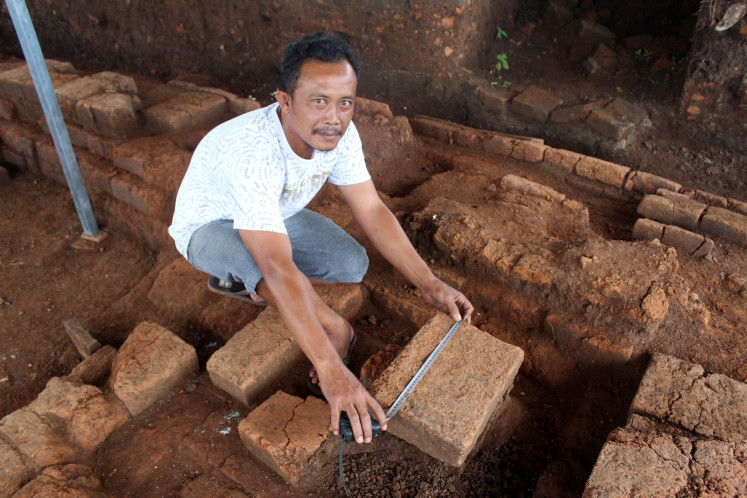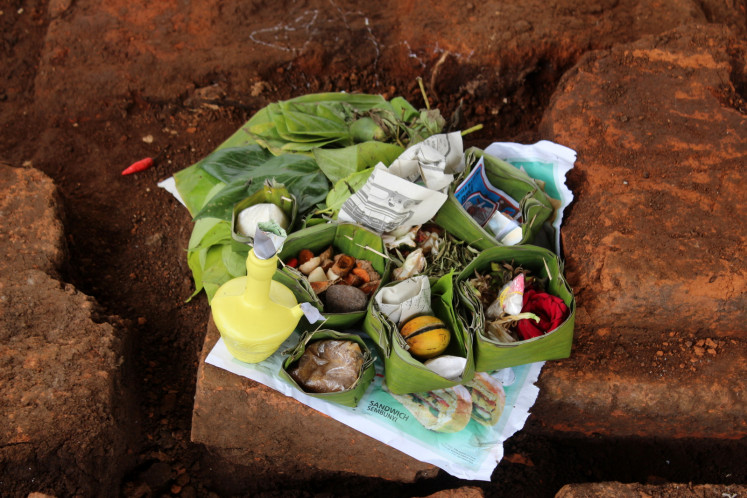Popular Reads
Top Results
Can't find what you're looking for?
View all search resultsPopular Reads
Top Results
Can't find what you're looking for?
View all search resultsDigging up the red brick past
Change text size
Gift Premium Articles
to Anyone
A
villager’s regular dig of avocado plants led to a discovery that might further boost the town of Batu’s reputation as a tourist spot.
One Friday last November, 40-year-old Anton Adi Wibowo reckoned it was about time he tackled a task he had long avoided.
His family’s 1,000 square meter block in Pendem village near the East Java resort of Batu was just going to waste. It was producing weeds, not income.
On one side neighbors were growing rice. On the other a small cemetery, the resting place for 60 souls.
Wibowo owns a metal workshop. He’s also the elected community head. He did not want a high-maintenance crop so chose avocados. The loam was known to be deep but just 40 centimeters down his sharp spade shuddered and stopped.
He had hit a big red brick. Alongside was another. More digging exposed an orderly line.
Wibowo did not know what he had found but realized it was important and should be reported. He had heard of another historical site that had been smashed by religious fanatics and did not want that to happen again.
Discoverer Anton Adi Wibowo. (JP/Erlinawati Graham)“There had been occasional discoveries of brick pieces by gravediggers but this was quite different,” he said.
“The bricks were intact and clearly part of construction. I stopped planting avocados. I was happy, excited and surprised.”
A few days after Wibowo struck brick, a 10-person team from the Trowulan East Java Cultural Preservation Center arrived and rapidly realized they were onto something special.
Their trowel and brush work had so far exposed 56 square meters of paving with what at first appeared to be a square dry well at the center surrounded by low walls. It was full of heavy boulders dumped higgledy-piggly.
At 2.1 sq m, the finding seems too large to be just a well. Archaeologist and Malang University history lecturer Dwi Cahyono says it’s the foundation pit for a three-stage temple tower that may have risen to 12 meters and was probably built a thousand years ago.
There are more questions than answers and few clues.
The best are the clay blocks, which measure 25 by 35 by 9 centimeters. They are much larger and heavier than the handy sharp-sided bricks used during the Majapahit Era (1293 to 1527), reinforcing the view that it was built earlier.
Cahyono said eight years ago he predicted a temple once served the area.
“In my 2012 ‘History of Batu’ I wrote about a Shiva Hindu temple not far from Pendem […] I based my theory on early 20th century Dutch writings, and from the discovery of a fragment of an Agastya [Hindu sage] statue near the village,” he said.
Just 400 meters to the west is the original site of the Prasasti Sanggurah stone tablet, which has inscriptions about King Wijayaloka who ruled what’s now Malang.
“It [the tablet] has information about land grants and the Mataram Kingdom,” Cahyono said.
Also known as the Medang Empire, the realm shifted from Central to East Java sometime during the 11th century. The reasons are unknown.
Wibowo and Cahyono were not the only ones moved by the discovery. So were the leaders and administrators of Batu. The town used to be part of Malang 20 kilometers to the southeast and 400 m below, but became a separate city in 2001.
It has a cool climate, vegetables and fruit, adventure playgrounds and hotels but lacks the bigger city’s serious stuff, which is the remnants of ancient temples. These include the eighth century candi badut (clown temple), the oldest in East Java.
If proved that earlier civilizations also occupied Batu, then local pride could be polished afresh and new marketing devised to lure culture tourists.
“We want to preserve our heritage and make it accessible,” said Batu tourist officer Parama Sari. “This may be a Hindu temple but that’s unimportant. It’s our national history.”
Offerings of rice and lime leaves have been left at the site along with joss sticks and a tiny charcoal burner.
Gift to the past: Offerings from the locals found at the temple site. (JP/Erlinawati Graham)Wibowo said these had been placed by “the community”, though all families in Pendem are said to be Muslim.
Two Dutch coins dated 1825 and bits of a broken bottle have been found among the rubble. Maybe in the mid 19thcentury looters were burrowing for booty, artifacts wanted by European collectors.
Alongside is an example of state vandalism.
Many years ago, a damaged stone pedestal yoni (womb in Sanskrit) representing the Hindu goddess Shakti was found together with a small statue of a cow. Clumsy attempts to repair with cement and steel rods have failed and the artifacts have been daubed by bureaucrats with white ID numbers.
The locals have already decided the bricks are the remnants of a temple and dubbed it candi mananjung, a word found inscribed on the Prasasti Sanggurah and the original name for Pendem village.
A light metal roof has been built over the diggings to protect from the weather and a fence erected to deter thieves. The only access is through a hole smashed through a small building storing a trolley used for moving corpses to the little cemetery alongside.
“I first became interested in history at school when I read about a temple in a magazine,” said Cahyono.
“This ‘candi’ is an extremely important find which tells us a little more about our country’s rich history. We’ll keep digging. The more we find the more we’ll know and understand.”













